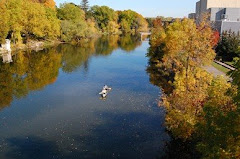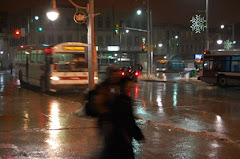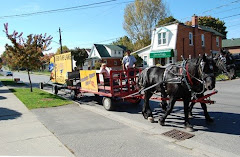23. There were 23 collisions on Guelph roads in a 22-hour stretch yesterday. Granted, the blizzard-like conditions came early this year, or at least earlier than we're used to, and while it hasn't been quite like what Buffalo is facing here in southern Ontario, it's still a cause for caution when you're out on the roads today. Courtesy of your local boys in blue, there are ways to stay safe while you're out driving to and from, stuff you can keep in mind all winter long.
Here are some winter driving tips provided by the Guelph Police Service:
See and be seen
If your vehicle is snow or ice covered, carefully clean all your windows and mirrors before setting out in the morning, and make sure you maintain visibility while driving. Be sure also to brush the snow off your front and rear lights. If you’re on a long trip, make sure you clean your lights whenever you stop for gas.
Slow down
Everything takes longer on a slippery surface. It takes longer to start from a standstill, longer to stop, longer to change lanes. Even vehicles with all-wheel drive, which have superior traction when starting, will have trouble when stopping.
So take it easy, and don’t try anything sudden. Use limited pedal pressure when starting, don’t attempt sharp turns at speed, and begin braking well in advance of where you want to stop.
Make room in front of you.
The biggest cause of accidents on any surface is not having enough time to stop. That goes double for slippery surfaces. When driving on dry surfaces, the rule of thumb is two-seconds between your car, and the car in front of you (no matter what your speed).
Using the “two-second rule,” it’s easy to determine if you’re too close. Simply pick a spot on the side of the road, and when the car in front of you passes that spot, start counting (one thousand one, two thousand two). If you reach that spot before two seconds have elapsed, you’re too close.
But that’s in dry conditions. Many driving experts recommend doubling this to four-seconds on slippery surfaces, because when you have to stop quickly on snow or ice, your car is likely to behave unpredictably. If you have more time, you have more distance in which to stop safely.
Make room behind you
How can you do this? Check your rear-view mirror frequently, and if the car behind persists in following too closely, move into the lane beside you and let the following car by. If you’re not on a highway, and somebody’s right on your tail, maintain your speed until it’s safe to pull over, do so, and let the following vehicle by. Resume driving when the way is clear.
Leave extra space when stopped
When stopped behind a car at a stoplight, or in stop-and-go traffic, you should leave enough space to see the rear wheels of the car ahead. This gives you enough room to pull out and move around the car if it stalls, and it enables you to pull ahead if you see a car approaching too fast from behind. But again, in winter, why not leave some extra space? If someone’s sliding towards you from the rear, you can move into that space, and that may be the difference between a collision and a near miss. Do check your rear view mirror when slowing down, and when stopped so you know what’s going on behind you.
Use defensive braking
This isn’t a technique that’s taught much anymore, but it’s a good one. When driving along, if you see traffic stopping ahead, or a light changing to red, tap your brake pedal, and the flash of your brake lights will alert the following car that you are about to stop. You can do this a good distance away from where you will stop, and it may be enough to bring someone’s attention back from their cell phone, or from their daydream, before slamming on their brakes too late.
Learn to anticipate
This is a driving skill for all seasons, but especially important in the winter. Regularly look well ahead to identify hazards. This could take the form of brake lights coming on a kilometer down the road, or the flashing lights of emergency or road clearing vehicles. If you know what you’re driving into, you can adequately prepare. Learn to identify “stale” green lights at intersections, by checking the status of the Walk/Don’t Walk signals as you approach them (if it’s flashing, your green light’s about to turn red). Minimize the need to react suddenly.
Change lanes carefully
When it’s really snowy, cars travelling down the highway will often cause ridges of slush between the lanes. Changing lanes through that ridge of slush or ice can dramatically upset the vehicle. The technique is to pick your spot (where there’s the least amount of slush between lanes), signal in advance, maintain a steady speed, and hold the steering wheel firmly as you cross from one lane to the next.
Watch and adjust for black ice
If you’ve ever tried to walk on black ice, you know how slippery it is. At speed, cars have very limited control on this surface (slowly decelerating is about all you can do). What keeps the vehicle going in a straight line is its momentum, and not attempting to change direction. Fortunately, black ice typically occurs in specific places: on bridges, on highway overpasses, and in shaded areas. However, ice can be particularly slick on a frigid, sunny day at intersections, where your brakes (anti-lock or not) and steering may have no effect at all.
If you’re on the highway and you suspect black ice ahead, take your foot off the accelerator, line the car up, and let its momentum carry you through the slippery area. If you’re in town, anticipate the slippery intersection, and slow down much earlier than you usually would, so that you almost coast to a halt.
Starting in slippery conditions
If you drive a vehicle with a manual transmission, try using second gear when starting on slippery surfaces (this reduces torque to the wheels, and decreases their tendency to spin). The automatic transmissions of some cars (Saab, for example) have a winter mode, which causes the car to start in second or third gear. Other automatics may have a “manual” mode that permits you to shift to a higher gear, but basic automatic transmissions will start in first, no matter what the conditions. In this case, start slowly, with gentle pressure on the accelerator.
Test your brakes if you’re unsure of the road surface
A key problem when driving in winter is that traction may me compromised by slippery surfaces. If you’re unsure of the road surface on which you’re driving, pick a spot where you’re clear of traffic, and carefully apply your brakes to see how your vehicle reacts (you don’t have to actually stop, just determine what’s going to happen). If you feel your brakes lock, or the car begin to slide, you know the surface is particularly slippery and that you should adjust by slowing down.
Finally, one of the most well-known Canadian winter driving techniques is escape south sometime around November. Find a nice sunny spot, enjoy the weather, and come back in spring.


















No comments:
Post a Comment